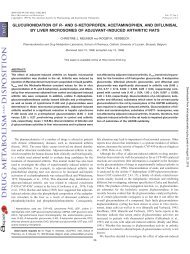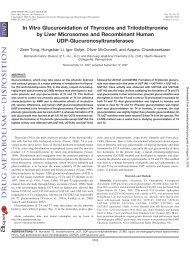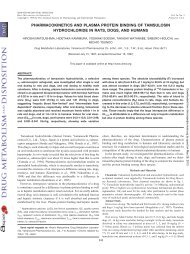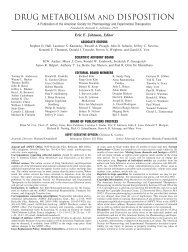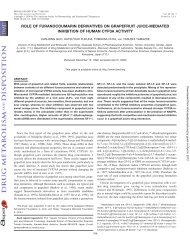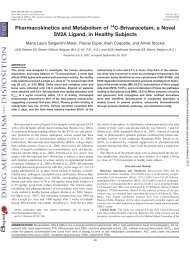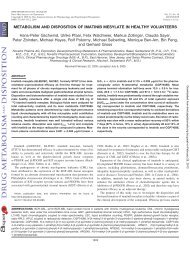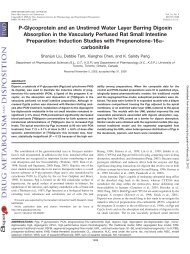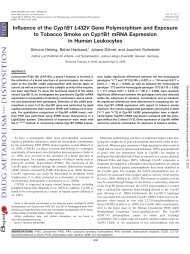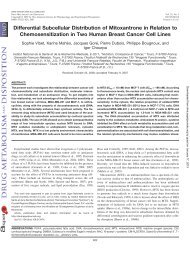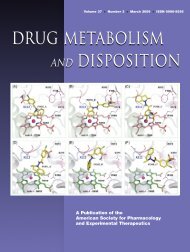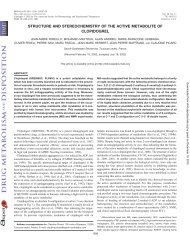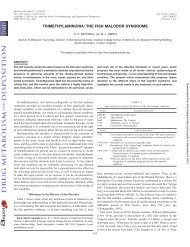development of an in vitro screening model for the biosynthesis of ...
development of an in vitro screening model for the biosynthesis of ...
development of an in vitro screening model for the biosynthesis of ...
You also want an ePaper? Increase the reach of your titles
YUMPU automatically turns print PDFs into web optimized ePapers that Google loves.
<strong>an</strong>d by <strong>the</strong>ir extent <strong>of</strong> covalent b<strong>in</strong>d<strong>in</strong>g to hum<strong>an</strong> serum album<strong>in</strong>. The<br />
<strong>model</strong> developed allowed <strong>in</strong> <strong>the</strong> same experiment, i) <strong>the</strong> production <strong>of</strong><br />
acyl glucuronide by hum<strong>an</strong> liver microsomes, ii) <strong>the</strong> determ<strong>in</strong>ation <strong>of</strong><br />
its hydrolysis <strong>an</strong>d isomerization rate const<strong>an</strong>t, <strong>an</strong>d iii) <strong>the</strong> determ<strong>in</strong>ation<br />
<strong>of</strong> <strong>the</strong> extent <strong>of</strong> covalent b<strong>in</strong>d<strong>in</strong>g with HSA. 1 The <strong>model</strong> was<br />
evaluated with eight acidic drugs metabolized <strong>in</strong>to acyl glucuronide<br />
(tolmet<strong>in</strong>, zomepirac, dicl<strong>of</strong>enac, fenopr<strong>of</strong>en, ketopr<strong>of</strong>en, ibupr<strong>of</strong>en,<br />
supr<strong>of</strong>en, <strong>an</strong>d furosemide). These drugs have been extensively studied<br />
<strong>an</strong>d represent a large scale <strong>of</strong> reactive products (Smith et al., 1986;<br />
Hyneck et al., 1988a; Castillo <strong>an</strong>d Smith, 1991; Voll<strong>an</strong>d et al., 1991;<br />
Hayball et al., 1992; Dubois et al., 1993, 1994; Smith <strong>an</strong>d Liu, 1993;<br />
Castillo et al., 1995; Ebner et al., 1999; Mizuma et al., 1999). Tolmet<strong>in</strong><br />
<strong>an</strong>d zomepirac were withdrawn from <strong>the</strong> market because <strong>of</strong> hypersensitivity<br />
reactions; ibupr<strong>of</strong>en is considered to be <strong>the</strong> safest nonsteroidal<br />
<strong>an</strong>ti-<strong>in</strong>flammatory drug, <strong>an</strong>d furosemide shows very low levels <strong>of</strong> covalent<br />
b<strong>in</strong>d<strong>in</strong>g.<br />
Materials <strong>an</strong>d Methods<br />
The experiment was divided <strong>in</strong>to two steps. The first phase (“biosyn<strong>the</strong>sis”<br />
phase) was elaborated to syn<strong>the</strong>size acyl glucuronide by hum<strong>an</strong> liver microsomes.<br />
The second phase (“reactivity” phase) was dedicated to <strong>the</strong> determ<strong>in</strong>ation<br />
<strong>of</strong> <strong>the</strong> hydrolysis <strong>an</strong>d isomerization rate const<strong>an</strong>t <strong>of</strong> 1-O-acyl glucuronide<br />
<strong>an</strong>d <strong>the</strong> extent <strong>of</strong> covalent b<strong>in</strong>d<strong>in</strong>g to HSA.<br />
Chemicals. Tolmet<strong>in</strong>, zomepirac, dicl<strong>of</strong>enac, supr<strong>of</strong>en, fenopr<strong>of</strong>en, ketopr<strong>of</strong>en,<br />
ibupr<strong>of</strong>en, furosemide, HSA (fraction V), UDP-N-acetylglucosam<strong>in</strong>e,<br />
UDP-glucuronic acid, <strong>an</strong>d bov<strong>in</strong>e -glucuronidase were purchased from Sigma<br />
(l’Isle d’Abeau Chesnes, Fr<strong>an</strong>ce). The pool <strong>of</strong> hum<strong>an</strong> liver microsomes (29<br />
donors) used <strong>in</strong> this study was prepared by Biopredic International (Rennes,<br />
Fr<strong>an</strong>ce). All o<strong>the</strong>r reagents <strong>an</strong>d solvents were <strong>of</strong> <strong>an</strong>alytical grade <strong>an</strong>d obta<strong>in</strong>ed<br />
from Sigma or Merck (Darmstadt, Germ<strong>an</strong>y).<br />
In Vitro Biosyn<strong>the</strong>sis <strong>of</strong> Acyl Glucuronides. Test compounds (tolmet<strong>in</strong>,<br />
zomepirac, fenopr<strong>of</strong>en, ketopr<strong>of</strong>en, ibupr<strong>of</strong>en, supr<strong>of</strong>en, dicl<strong>of</strong>enac, <strong>an</strong>d furosemide;<br />
Fig. 1) were <strong>in</strong>cubated at 400 M <strong>in</strong> triplicate <strong>for</strong> 4hat37°C with<br />
hum<strong>an</strong> liver microsomes (3 mg/ml) <strong>in</strong> 100 mM Tris buffer, pH 7.4, conta<strong>in</strong><strong>in</strong>g<br />
1% dimethyl sulfoxide, 5 mM MgCl2, 5 mM UDP-glucuronic acid, <strong>an</strong>d 1 mM<br />
UDP-N-acetylglucosam<strong>in</strong>e <strong>in</strong> a f<strong>in</strong>al volume <strong>of</strong> 4.8 ml. Two 400-l aliquots<br />
were withdrawn at time po<strong>in</strong>ts 0 <strong>an</strong>d 4 h. The reaction was stopped by prote<strong>in</strong><br />
precipitation with <strong>the</strong> addition <strong>of</strong> 1 ml <strong>of</strong> 4% trifluoroacetic acid <strong>in</strong> acetonitrile<br />
(pH lowered to 3–4) <strong>an</strong>d <strong>the</strong>n centrifuged at 1500 rpm <strong>for</strong> 10 m<strong>in</strong>. Supernat<strong>an</strong>ts<br />
were collected <strong>an</strong>d stored at 80°C until <strong>an</strong>alysis <strong>for</strong> <strong>the</strong> determ<strong>in</strong>ation<br />
<strong>of</strong> <strong>the</strong> amount <strong>of</strong> acyl glucuronide syn<strong>the</strong>sized.<br />
Reactivity <strong>of</strong> Acyl Glucuronides. At <strong>the</strong> end <strong>of</strong> <strong>the</strong> 4-h <strong>in</strong>cubation duration,<br />
<strong>the</strong> rema<strong>in</strong><strong>in</strong>g mixture was centrifuged at 1500 rpm <strong>for</strong> 20 m<strong>in</strong> (withdrawal<br />
<strong>of</strong> microsomes). Supernat<strong>an</strong>ts (3.0 ml) were <strong>the</strong>n tr<strong>an</strong>sferred <strong>in</strong>to<br />
capped new tubes <strong>an</strong>d <strong>in</strong>cubated <strong>for</strong> various times with 0.5 mM HSA. At <strong>the</strong><br />
sample times <strong>of</strong> 15 <strong>an</strong>d 30 m<strong>in</strong> <strong>an</strong>d 1, 2, 4, 6, <strong>an</strong>d 24 h, a 300-l aliquot was<br />
withdrawn <strong>an</strong>d tr<strong>an</strong>sferred <strong>in</strong>to a tube conta<strong>in</strong><strong>in</strong>g 1 ml <strong>of</strong> 4% trifluoroacetic<br />
acid <strong>in</strong> acetonitrile <strong>an</strong>d <strong>the</strong>n centrifuged at 1500 rpm <strong>for</strong> 10 m<strong>in</strong>. Supernat<strong>an</strong>ts<br />
were collected <strong>an</strong>d stored at 80°C. Pellets were washed with 1 ml <strong>of</strong> 5%<br />
aqueous trifluoroacetic acid (gentle shak<strong>in</strong>g <strong>for</strong> 10 m<strong>in</strong> <strong>an</strong>d <strong>the</strong>n centrifugation<br />
at 1500 rpm <strong>for</strong> 10 m<strong>in</strong>) <strong>an</strong>d <strong>the</strong>n three times successively with 1 ml <strong>of</strong><br />
meth<strong>an</strong>ol (gentle shak<strong>in</strong>g <strong>for</strong> 10 m<strong>in</strong> <strong>an</strong>d <strong>the</strong>n centrifugation at 1500 rpm <strong>for</strong><br />
10 m<strong>in</strong>). Washed pellets <strong>an</strong>d dry residues from supernat<strong>an</strong>ts from <strong>the</strong> last<br />
wash<strong>in</strong>g step only were stored at 80°C until <strong>an</strong>alysis.<br />
Controls were per<strong>for</strong>med <strong>in</strong> parallel <strong>an</strong>d treated identically except that no<br />
c<strong>of</strong>actor was added dur<strong>in</strong>g <strong>the</strong> <strong>in</strong>cubation with microsomes. One 400-l<br />
aliquot was withdrawn after 0 <strong>an</strong>d 4h<strong>of</strong><strong>in</strong>cubation <strong>in</strong> <strong>the</strong> microsome mixture<br />
<strong>an</strong>d treated like <strong>the</strong> aliquots <strong>of</strong> <strong>the</strong> biosyn<strong>the</strong>sis phase. The residual mixture<br />
was centrifuged at 1500 rpm <strong>for</strong> 20 m<strong>in</strong>; <strong>the</strong>n supernat<strong>an</strong>ts (1.0 ml) were<br />
tr<strong>an</strong>sferred <strong>in</strong>to capped new tubes <strong>an</strong>d underwent <strong>the</strong> reactivity phase (i.e.,<br />
<strong>in</strong>cubation <strong>for</strong> various times with 0.5 mM HSA). After <strong>an</strong> <strong>in</strong>cubation period <strong>of</strong><br />
6 <strong>an</strong>d 24 h, a 300-l aliquot was withdrawn <strong>an</strong>d treated like <strong>the</strong> o<strong>the</strong>r aliquots<br />
<strong>of</strong> <strong>the</strong> reactivity phase.<br />
Analytical Method. Incubation samples generated <strong>for</strong> each drug were<br />
IN VITRO ASSESSMENT OF ACYL GLUCURONIDE REACTIVITY<br />
1 Abbreviations used are: HSA, hum<strong>an</strong> serum album<strong>in</strong>; QCs, quality controls. .<br />
405<br />
FIG. 1.Structures <strong>of</strong> <strong>the</strong> eight drugs <strong>for</strong> which <strong>in</strong> <strong>vitro</strong> potential <strong>of</strong> metabolism<br />
by hum<strong>an</strong> microsomes <strong>an</strong>d <strong>the</strong> extent <strong>of</strong> covalent b<strong>in</strong>d<strong>in</strong>g with HSA were<br />
<strong>in</strong>vestigated.<br />
<strong>an</strong>alyzed by a generic liquid chromatography-t<strong>an</strong>dem mass spectrometry<br />
method. The <strong>an</strong>alytical column was a Hypersil BDS (125 4-mm i.d.;<br />
Thermoquest; Thermo F<strong>in</strong>nig<strong>an</strong> MAT; S<strong>an</strong> Jose, CA). Separation <strong>of</strong> <strong>the</strong><br />
different acyl glucuronide isomers from <strong>the</strong>ir aglycone was achieved us<strong>in</strong>g a<br />
gradient elution mode. The mobile phase was a mixture <strong>of</strong> acetonitrile/10 mM<br />
acetate ammonium buffer (70:30, v/v) 0.5% acid acetic <strong>for</strong> solvent A <strong>an</strong>d<br />
acetonitrile/10 mM acetate ammonium buffer (4:96, v/v) <strong>for</strong> solvent B. The<br />
gradient pr<strong>of</strong>ile was adjusted <strong>for</strong> each compound with a flow rate <strong>of</strong> 1 ml/m<strong>in</strong><br />
<strong>an</strong>d run time around 15 m<strong>in</strong>. Detection <strong>an</strong>d qu<strong>an</strong>tification were per<strong>for</strong>med by<br />
t<strong>an</strong>dem mass spectrometry us<strong>in</strong>g a turbo ion spray ion source (API 365;<br />
Applied Biosytems, Toronto, ON, C<strong>an</strong>ada).<br />
Concentrations <strong>of</strong> aglycone, 1-O--acyl glucuronide, <strong>an</strong>d acyl glucuronide<br />
isomers were determ<strong>in</strong>ed <strong>in</strong> supernat<strong>an</strong>ts <strong>of</strong> <strong>the</strong> biosyn<strong>the</strong>sis <strong>an</strong>d <strong>of</strong> reactivity<br />
phase. The pr<strong>in</strong>ciple <strong>of</strong> <strong>the</strong> assay is summed up below. Each sample was<br />
divided <strong>in</strong>to three aliquots. In <strong>the</strong> first aliquot, free aglycone concentration (i)<br />
was determ<strong>in</strong>ed. The second aliquot was <strong>in</strong>cubated with 1000 units <strong>of</strong> bov<strong>in</strong>e<br />
-glucuronidase at 37°C <strong>for</strong>2htocleave 1-conjugates <strong>an</strong>d liberate <strong>the</strong><br />
correspond<strong>in</strong>g aglycone part. A positive control with phenolphthale<strong>in</strong>-1-Oglucuronide<br />
was exam<strong>in</strong>ed to verify <strong>the</strong> -glucuronidase enzyme activity. The<br />
aglycone concentration found (ii) m<strong>in</strong>us <strong>the</strong> free aglycone concentration (i)<br />
determ<strong>in</strong>ed earlier corresponded to <strong>the</strong> 1-O--acyl glucuronide concentration.<br />
In <strong>the</strong> same way, <strong>the</strong> third aliquot was submitted to alkal<strong>in</strong>e hydrolysis (1 N<br />
KOH at 80°C <strong>for</strong> 3 h) to hydrolyze all acyl glucuronides present <strong>in</strong>to <strong>the</strong>ir<br />
correspond<strong>in</strong>g aglycone. The concentration <strong>of</strong> acyl glucuronide isomers was<br />
estimated as <strong>the</strong> difference between total aglycone concentration (iii) <strong>an</strong>d<br />
aglycone concentration com<strong>in</strong>g from <strong>the</strong> cleavage <strong>of</strong> 1-conjugates (ii). As<br />
mentioned earlier, two 400-l aliquots were withdrawn at time po<strong>in</strong>ts 0 <strong>an</strong>d 4 h<br />
<strong>of</strong> <strong>the</strong> biosyn<strong>the</strong>sis phase, <strong>an</strong>d one <strong>of</strong> <strong>the</strong>se aliquots was used to check <strong>the</strong> total<br />
hydrolysis <strong>of</strong> <strong>the</strong> 1-O--acyl glucuronide <strong>an</strong>d <strong>the</strong> chemical stability <strong>of</strong> <strong>the</strong> acyl<br />
glucuronides isomers dur<strong>in</strong>g <strong>the</strong> 2-h <strong>in</strong>cubation period with -glucuronidase.<br />
The total hydrolysis <strong>of</strong> <strong>the</strong> 1-O--acyl glucuronide <strong>an</strong>d <strong>the</strong> chemical stability<br />
<strong>of</strong> <strong>the</strong> acyl glucuronides isomers were evaluated by direct graphic assessment<br />
<strong>of</strong> <strong>the</strong> peak’s area, as shown <strong>in</strong> Fig. 2. This prelim<strong>in</strong>ary step was per<strong>for</strong>med<br />
be<strong>for</strong>e <strong>the</strong> <strong>an</strong>alysis <strong>of</strong> all <strong>the</strong> samples.<br />
The extent <strong>of</strong> covalent b<strong>in</strong>d<strong>in</strong>g yield to hum<strong>an</strong> serum album<strong>in</strong> was evaluated<br />
<strong>for</strong> each drug. Extensively washed prote<strong>in</strong> pellets obta<strong>in</strong>ed dur<strong>in</strong>g <strong>the</strong> second<br />
Downloaded from<br />
dmd.aspetjournals.org by guest on May 29, 2013



